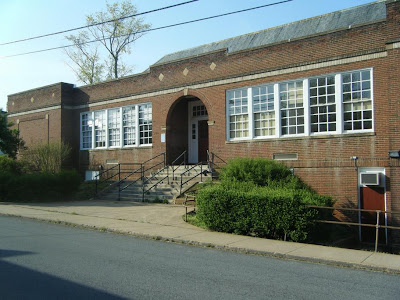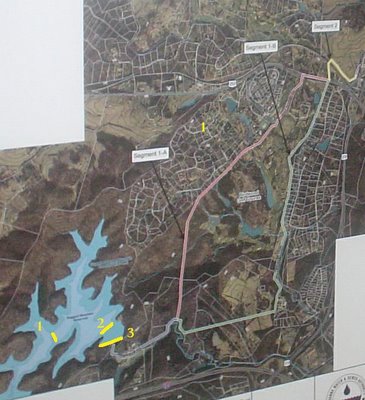2007: Levy Ave one of Many Stories

600 block Levy Avenue circa 1971.

View today, same retaining wall and telephone pole at center of photo.
Charlottesville, Virginia--On November 11, the latest plans to redevelop the 600 block of Levy Avenue made the front page of the Sunday Daily Progress ("City reworking mixed-income project" by Seth Rosen).
Of the 10 parcels that make up the site, the Housing Authority purchased 2 in 1971 and seized the other 8 in 1972. The original purpose of the acquisition was redevelopment, "necessary for the development of an urban renewal project" as court documents record. Established by referendum 1954, the Authority rents the cleared and consolidated parcel to the city as an employee parking lot for $1 a year.
The Progress story traces the history of this particular project only 4 years, 3 requests for proposals and 4 public meetings. They have an update on the latest developer to think twice after due diligent research.
"The authority signed a letter of intent in September 2006 to partner with the Blue Moon Fund on redeveloping the parking lot. Though the plans were in their earliest stages, housing authority officials hoped to build several townhouses, some cottages and two condo buildings with office space. Some of the units would then be sold at market-rate, while others would be sold at subsidized rates to low-income and public housing residents.
But the housing board came to the conclusion that it did not make sense to move forward with the project while the authority is exploring ways to redevelop some of its 376 [public housing] units [...]
Blue Moon officials did not return calls last week seeking comment."
The newspaper reported on the Levy redevelopment in 2003 but didn’t say when the property was acquired (“City has plan for Levy site: Mixed income idea novel for housing” by Elizabeth Nelson, June 19, 2003). In 2006 the paper reported the Housing Authority has owned the property for decades “colloquially known as the Levy Avenue lot” (“Belmont-area development considered: Affordable housing planned” by John Yellig, Dec. 15, 2006). Levy is the site’s legal name recorded in numerous deeds between 1891 and 1972, maps and publications. The reporter had not done any research that requires reading, not even the archives of his own paper.
In 2003 Mayor Maurice Cox held a public meeting where folks envisioned Granny-flat studio apartments above store fronts and a backyard mini-park ("Levy Avenue Design Workshop," Belmont-Carlton Neighborhood Association Newsletter, Summer 2003). In January ’06 they wanted 30 units, single-family houses and townhouses. In December ’06 it was 7 houses and a dozen condos.
Why did this story move to the front page? If you know the back-story, front page is appropriate. But the newspaper didn’t share any of that background.
How come? The Daily Progress appears to have two distinct policies.
1. Vinegar Hill is the only urban renewal in Charlottesville.
2. No urban renewal is occurring today, at least, not in Charlottesville.
The 35-year project, all by itself, debunks both of those myths. Redevelopment is not complete until the seized property is sold. The urban area is not renewed until new development is built.
Levy does not stand alone. It’s part of a much larger urban renewal project. The social fabric on this block was representative of much of Charlottesville. The modern rhetoric and zoning seek to bring back what was lost: mixed income, mixed use, affordable housing, environment, history, sense of security, and so on. How did these myths take hold?
Newspapers turn oral history into history. Reporters quote officials. As Sally Hemings’ descendants have learned, oral history is not history because it’s not written down. But if the officials are not telling the whole story, the article becomes revisionist history. Reporters later refer back to a documented myth. By not doing his homework and reading other sources, the reporter succumbs to Bush syndrome: didn’t lie but didn’t tell the truth either. It’s not his fault he trusted the official. Now that he knows the truth, that’s no reason to write a correction or update. In a couple years he’ll be at another newspaper based on his headlines and layout since no one will read the article anyway.
If you ask our local leaders about urban renewal, they’ll tell you about the early 1960s Vinegar Hill clearance a few years before they took office. That’s like asking a World War Two veteran about the war. And he talks about World War One. Why don’t they talk about the issues their experience indicates they should know something about?
Difficult underlying Truth. You are a civil rights opponent if you support eminent domain for what only due process allows: seize and sell real estate. Public housing is more tricky where a private residence is construed to be a public use. Civil rights are listed in the Bill of Rights, a list of limitations on the government. If the government goes beyond those limits, that is against the supreme law of the land. Government does not have rights. There’s no function of government that can’t be limited or prohibited by the people.
Why would you expect public housing to be safe? It’s a perpetual crime scene. The landlord violated someone else’s civil rights to acquire the property you now rent. So you’ve become an unwitting accomplice. Safety is often the tradeoff when you benefit directly from the poison fruit of injustice. So the announcement today that police would step up patrols of public housing sites was ironic. If you don’t give up your land voluntarily, who actually evicts you? And there’s talk of creating a citizens review board to oversee the police following complaints. Yet somehow this ball of contradictions keeps on rolling.
Tale of three newspapers. C-ville Weekly maintains the Vinegar Hill myth, except they allow letters to the contrary. C-ville had a makeover beginning this year where they refer back to articles where they wrote down some official’s selective oral history.
The Hook is unique in that they can mention taboo history in passing. The editor Hawes Spencer has grown a lot since the days of 2000 as editor of C-ville Weekly. The old Hawes lives on in the modern C-ville Weekly. I like the new Hawes better. When there’s a photo retrospective of Garrett Street then and now, that will be a major breakthrough in local journalism.
(This is the fourth and final retrospective from 2007.)
"West Main: Then and Now" by Dave McNair. Jan. 17, 2008. The Hook. First newspaper since 2000 (since I've been paying attention) to acknowledge Jefferson School's roots on West Main.
"Where's the Pork? The Rise and Fall of the Hogwaller name" by Adam Sorensen. Nov. 29, 2007. The Hook. Progress and C-ville would have left out mention of Garrett Street.
"The livestock market got its start on Garrett Street in the 1800s before moving just southeast of Douglas Avenue, along the bustling C&O rail yard the City converted to an office park in the late 1980s. It moved to its current site at 801 Franklin Street in 1946."
"Pimping Preston: Is a roundabouted boulevard the answer?" by Dave McNair. Jul 26, 2007, The Hook. 4-Lane highway for 5 blocks.
"Indeed, for [UVA architecture professor Elizabeth] Meyer, Preston's current layout is the result of something far more troubling and complicated than bad design.
"It's the result of an urban renewal program that demolished numerous homes owned by African Americans in the area," she says. "Through its width and topographic changes, Preston disconnected the Rose Hill and Tenth and Page neighborhoods. The problem there is social and aesthetic . Like so many 1960s-70s 'urban renewal' conditions in Charlottesville, topographic changes made for roads and buildings created or reinforced racial differences."
Levy Avenue update: All 5 owners identified, Nov. 17, 2007
Levy Avenue for sale: Eminent domain in you face, Dec. 15, 2006
Search Charlottesville online real estate records.

1935 Charlottesville, Vinegar Hill, Preston, West Main, Garrett, Mall

1907 Charlottesville, Ridge, Parrott, Diggs,S. First, W. Garrett, South St., Midway School.

The Ware Lot sold for development 1915, on east side of S. First.

The Ware house, in the notch at end of Ware St, extended for 1929 Ix textile factory, Elliott Ave extension post 1935.

The 1915 plat for Ware subdivision.

Deed of Sale. Deed Book 27 Page 371, June 12, 1915.

Deed of Sale. Deed Book 27 Page 372, June 12, 1915.

Rare photo of Marguerite's Bordello at 303 Fifth Street SE 1922-1951. House built 19th century, razed 1972

"Urban Renewal South: The Best-known Secret in Charlottesville's History", March 5, 2002.

Excerpts from "Marguiretta's: Charlottesville's Legendary House of Ill Repute" by Kathleen Phalen, 1997.










